In the field of modern biotechnology, cell culture flasks are a crucial cell culture vessel, especially in adherent cell culture with a wide range of applications. In order to ensure product quality, its production environment must meet strict standards and requirements.
1. Class C Cleanroom
The production of cell culture flasks must be carried out in a Class C clean room, which means that the total number of microorganisms in the air does not exceed 1000 per cubic meter, and the total number of microorganisms in the air does not exceed 1000 particles with a particle size larger than 5 microns. This level of cleanliness can effectively reduce the airborne microorganisms and particles contamination to ensure that the production process is not contaminated by the external environment.

2. ISO13485 quality management system requirements
ISO13485 is an international standard for quality management systems for medical devices and one of the standards that must be followed for the production of cell culture flasks. The standard specifies the quality management system requirements that medical device manufacturers should establish, implement and maintain to ensure product safety and effectiveness. Following ISO13485 quality management system requirements can help manufacturers establish a strict quality management system to ensure the quality of their products.
3. Temperature and humidity control
The production process of cell culture flasks requires strict control of temperature and humidity. Changes in temperature and humidity may affect the molding quality of the product, so measures must be taken during the production process to ensure that the temperature and humidity of the production environment are within the appropriate range.
In summary, cell culture flasks have strict requirements for the production environment, including production in a Class C clean room, following ISO13485 quality management system requirements, and controlling temperature and humidity. Only in a production environment that meets these strict standards can the product quality and consistency of cell culture flasks be ensured, thus providing reliable support for scientific research and applications in the field of cell culture.
Translated with DeepL.com (free version)
The FAI climbed 5.9 percent year-on-year in the first 11 months of 2018, quickening from the 5.7-percent growth in Jan-Oct, the National Bureau of Statistics (NBS) said Friday in an online statement.
The key indicator of investment, dubbed a major growth driver, hit the bottom in August and has since started to rebound steadily.
In the face of emerging economic challenges home and abroad, China has stepped up efforts to stabilize investment, in particular rolling out measures to motivate private investors and channel funds into infrastructure.
Friday's data showed private investment, accounting for more than 60 percent of the total FAI, expanded by a brisk 8.7 percent.
NBS spokesperson Mao Shengyong said funds into weak economic links registered rapid increases as investment in environmental protection and agriculture jumped 42 percent and 12.5 percent respectively, much faster than the average.
In breakdown, investment in high-tech and equipment manufacturing remained vigorous with 16.1-percent and 11.6-percent increases respectively in the first 11 months. Infrastructure investment gained 3.7 percent, staying flat. Investment in property development rose 9.7 percent, also unchanged.
 English
English


















































